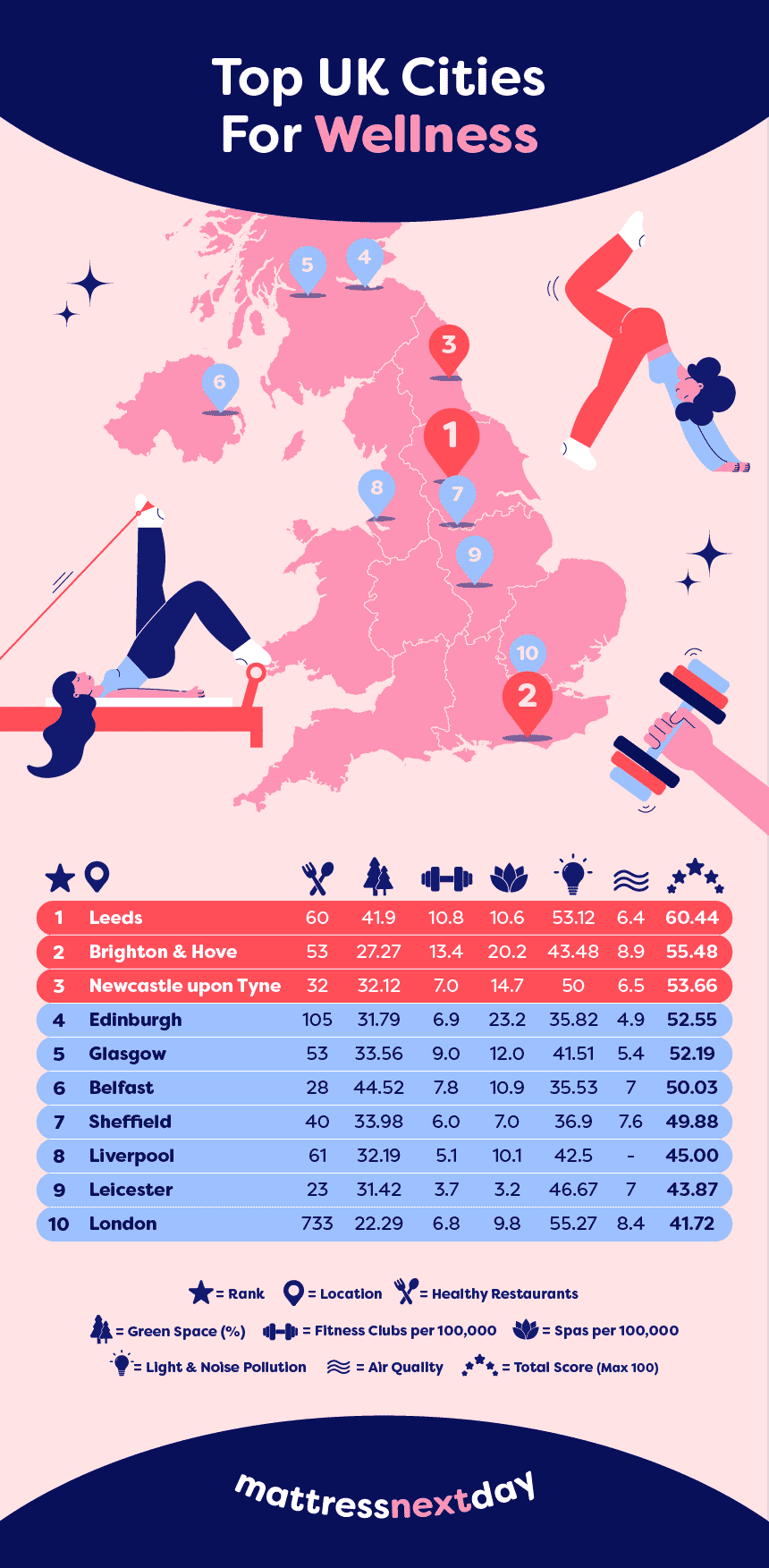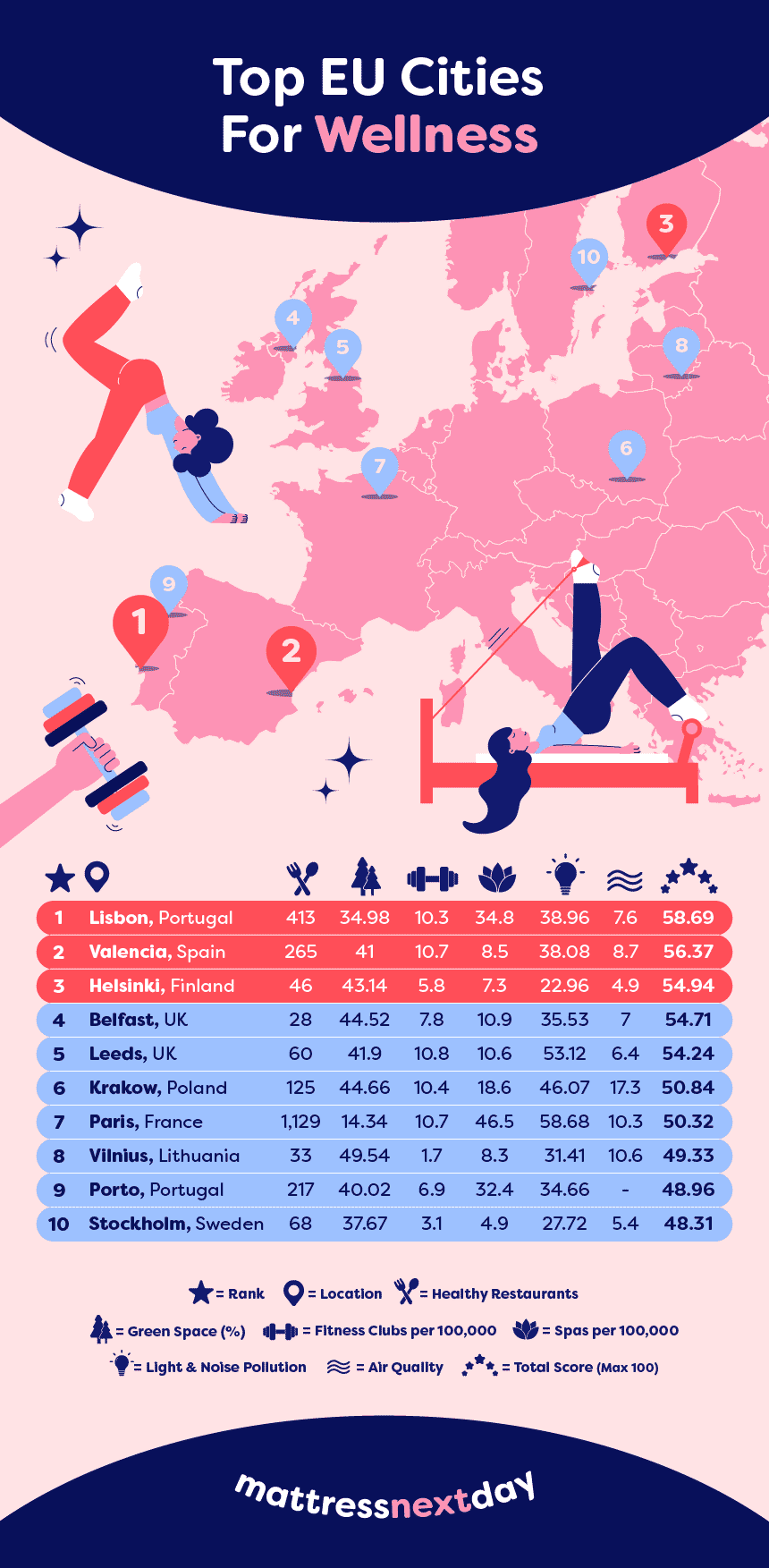Whether you’re a self-care guru who keeps an eye on all the latest healthcare trends, or an occasional runner who likes to get their steps in on the weekend, it’s safe to say that awareness and knowledge around valuable well-being activities and healthy living practices is definitely on the rise.
From weekly yoga sessions that help us switch off at night to focusing on healthy food options on a night out, personal prioritisation of self-care has become incredibly important for many of us, especially with regard to where we live.
Indeed, studies have shown a clear link between greenspace exposure and improved sleep, not to mention how easy access to gyms and wellness facilities increases the likelihood of sticking to any exercise routine. As a result, these factors are two among many to consider when upping sticks and moving to a new city.
But just which is the healthiest city in the UK and Europe for well-being spaces and for healthy living?
To find out, the team at MattressNextDay conducted a survey of over 20 UK and 60 European cities across the continent to find out which came top of the list for wellbeing, ranking them on factors such as the percentage of green space, gym prices, local spas, light and noise pollution, and more!
Find out which city came out on top, below!
Which is the healthiest city in the UK?
When it comes to living in any city, accessible social spaces and quiet neighbourhoods are must-have features for spending time with friends and getting a good night’s rest. Take a look below to see which UK cities came out on top for these and other factors:

1. Leeds
Coming in at number one with a total well-being score of 60.44 out of 100, we have Leeds. One of the largest cities in the North, Leeds already has a well-earned reputation for healthy living and for good reason.
For starters, Leeds has 60 healthy restaurants for residents and visitors to choose from, such as Wolflox and Eat Your Greens, putting it in the top 5 for this category, alongside the fourth-highest volume of green space overall for the 20 UK cities we ranked (41.9%) thanks in no small part to nearby beauty spots like Ilkley and Meanwood.
And the good news doesn’t stop there for Leeds residents, as the city also came fourth for gym prices (£27.85), second for gyms per 100,000 people (10.8), and third for air quality (6.4)!
In fact, the only factor that Leeds failed to break the top ten for was light and noise pollution. With a score of 53.12, Leeds is definitely a noisier city than most, but clearly not so loud as to stop thousands of people moving there every year.
2. Brighton & Hove
Next up, in second place, we have one of the South’s most popular areas – Brighton & Hove. Scoring 55.48 out of 100 in total, Brighton & Hove had the most gyms and fitness centres per 100,000 people than any other city we looked at (13.4), including well-known workout spots like Shredquarters and the Fitness Bar.
And despite not being known as a historic spa town, Brighton placed second for spas per 100,000 as well (20.2), just behind Edinburgh’s 23.2. Combine this with hospital wait times falling within the expected hours being an excellent 74.6% and Brighton has a lot going for it!
However, although Brighton has plenty of accessible fitness and wellbeing centres, gym prices and low air quality prevent it from beating Leeds to first place.
At £38.55 per month and an air quality rating of 8.9, Brighton had the fourth most expensive gym membership and fifth worst air quality of the 20 cities we looked at – though these factors definitely shouldn’t stop you from considering Brighton in your list of UK cities to visit.

3. Newcastle Upon Tyne
Moving back North for our third-place city, Newcastle fills out our top three with a score of 53.66. Much like Leeds, Newcastle didn’t necessarily come first in any one category, instead favouring consistency by landing mostly within the top five or ten for each of our factors.
But, with that being said, one area in which Newcastle does excel is in the number of spas available per 100,000 people, placing third, just beneath Brighton, with 14.7, as well as placing fourth for air quality with a brilliant 6.5.
On top of this, Newcastle only missed the top five for hospital wait times by one spot, coming in sixth with excellent waiting time resolutions of 74.1%. Add to this the fact that Newcastle has the ninth largest volume of green space (32.12%) and fitness clubs per 100,000 (7) and it's no real surprise that it placed so highly in our ranking.
4. Edinburgh
Staying in the North of the UK for the rest of our top five, the fourth city on our list is Scotland’s much-loved capital – Edinburgh – which earned 52.55 points out of 100 for its total wellbeing score.
Already a social and cultural hub that rivals most UK cities, Edinburgh was first overall for spas per 100,000 at 23.2, not to mention placing second for light and noise pollution (35.82) the only one of our top 5 cities to place in the top five for this factor!
Alongside this, Edinburgh was also second for healthy restaurants (105), thanks to iconic venues like Seeds For The Soul and Union of Genius, and even came first for air quality (4.9) – so with rankings like these, what stopped Edinburgh from coming in first?
Well, for one thing, Edinburgh’s hospital wait times are pretty dire, with just 58.5% being handled within 4 hours (the second worst overall), as well as having the second highest gym memberships at £42.50, only being beaten by London’s £47.91. But if you can look past these two areas, then Edinburgh has plenty of potential to be a wellbeing capital.
5. Glasgow
Last, but not least, to round out our top five UK cities, we have Glasgow and its score of 52.19. Again, Glasgow is another city that placed well in all factors if not first for any of them, though it does come close for air quality, getting the second spot beneath Edinburgh with a score of 5.4.
Not only that, but Glasgow is great for those seeking a city with low noise and light pollution, grabbing the sixth spot here (41.51), while also claiming the fifth spot for fitness clubs per 100,000 (9).
Round this off with its 53 healthy restaurants and a green space volume of 33.56% (putting it seventh for both of these) and Glasgow is well on its way to wellness excellence. Indeed, if Glasgow hadn’t placed third worst for gym prices (£38.94), it could very well have beaten Edinburgh and maybe even Newcastle for a higher spot on our list.
Which are the top EU cities for wellness?
So, we know which UK cities come out on top in terms of wellness and healthy living, but how well do the healthiest UK cities compare when pitted against their European counterparts:

1. Lisbon
Taking the first-place spot for health-conscious European cities, we have Lisbon. Scoring a respectable 58.69 out of 100, Lisbon hits many of the same notes as our top-placed UK cities – ranking highly in all factors without necessarily coming out on top in any.
Case and point, Lisbon was the fifth best European city for spas per 100,000 people (34.8) and healthy restaurants (413), as well as 17th for light and noise pollution (38.96) which is excellent when you consider our ranking was out of 60 cities total.
On top of these, Lisbon also proved to be the 20th best city for green space volume (34.98%), 13th for fitness clubs per 100,000 (10.23), and 14th for air quality (7.6), with gym prices being the only sticking point at £34.98 per month (though this still put Lisbon 35th overall).
2. Valencia
Passing over the border and into Spain for our next city, Valencia only scored slightly less than Lisbon with 56.37 points total. And, as you might expect, this means it was slightly lower than Lisbon in several categories, such as being seventh for healthy restaurants (265) to Lisbon’s fifth place.
However, this is certainly not the case in all areas. For example, Valencia was well ahead of Lisbon in green space volume (41%), placing 13th to Lisbon’s 20th, not to mention beating Lisbon substantially when it comes to wellness club prices at £29.96 (putting it 18th overall).
Valencia even beat Lisbon for fitness clubs per 100,000 (10.3), again coming 13th, but this is sadly where Valencia’s luck runs out, especially with regards to air quality (8.7) and spas per 100,000 (8.5), both of which put it well outside the top 20 in these areas. Thus, Lisbon retains the top spot (but only just), by dramatically outperforming Valencia in these areas.
3. Helsinki
Travelling over to the other side of Europe, Helsinki might be a bit chilly for some, but that’s in no way stopped it from becoming a wellness capital on the continent. Boasting a great score of 54.94, Helsinki has far more to offer visitors than traditional Scandinavian saunas and cold plunges.
First things first, Helsinki has the joint-best air quality of all the cities we looked at, matching Edinburgh with a score of 4.9, before storming ahead to first place in light and noise pollution with a rating of just 22.96! Add to this its ninth-place spot for green space volume (43.14%) and Helsinki is well on its way to beating Lisbon to number one!
However, this is actually where Helsinki’s top rankings end, with the city failing to come in the top 40 for any other category – including spas per 100,000 people, where it only placed 41st with 7.3. Still, despite this, Helsinki does more than enough to earn its third-place spot, and it’s definitely the city to be in for good sleep and clean air!

4. Belfast
Returning close to home for our fourth-place city, Belfast actually came sixth overall for UK cities, despite being outside our UK top five, and it even managed to beat out Leeds in our international rankings with a total wellness score of 54.71!
Indeed, Belfast placed respectably in many of our factors, including being sixth best for green space volume at 44.52% (the best out of our top 5), ninth best for light and noise pollution (35.53), and tenth best for air quality (7).
But even though Belfast excels in these areas, it still has room for improvement in others, such as healthy restaurants, where Belfast came 53rd with only 28 venues, not to mention being 32nd for gym prices at £33.40, which puts it below the middle. Fortunately, for the most part, Belfast performed well, making it a great wellness city choice to move to.
5. Leeds
Finally, for our fifth international city, we have Leeds making a return! Scoring 54.24 on our continent-wide factors, Leeds was the highest placed UK city in our European ranking thanks to all the reasons we mentioned before!
Continent-wide, Leeds had the fourth-best gym costs out of the 60 European cities we examined (£27.85), not to mention being eighth best for gyms per 100,000 (10.8) – the best out of our top 5,
And when you include the fact that Leeds also placed seventh for air quality (6.4) and twelfth for green space volume (41.9%), Leeds is really only held back from the higher spots by its comparatively lower number of healthy restaurants (60) and light pollution levels (53.12), where it placed 38th and 46th respectively.
What are the best wellness habits for improving sleep?
While all the cities we’ve discussed are great locations for anyone interested in creating a consistent wellness routine and improving their health habits, cities, by their very nature, aren’t always the calmest places to live.
Even the quietest cities are still somewhat noisy, and with city life being best described as hectic, it can often be hard to relax and unwind in the evening or when getting ready for bed.
However, as MattressNextDay’s Sleep Expert, Martin Seeley, points out, there are plenty of tips for how to sleep better in a busy city if you’re finding yourself regularly lying awake at night:
- Spend more time in nature – while not always possible on a daily basis, getting out into green spaces, particularly outside of the city, for a few hours a week can have a notable impact on improving your sleep. This is because exposure to natural light in green spaces can help reset your circadian rhythm, promoting the release of melatonin (the sleep hormone) and signalling your body to get tired in the evening. You can even try forest bathing as a way to calm your nervous system while in nature.
- Try more LISS sports – LISS (low-intensity steady-state) sports are a fantastic exercise option for anyone who doesn’t have the opportunity to work out regularly on a workday. Running, cycling, swimming, all of these activities will get your blood pumping, tiring your body out so that you feel ready to sleep when night falls.
- Practice mindful activities – whether this is yoga for sleep, meditation, or Pilates classes, mindfulness activities such as these have been shown to clear the mind of racing thoughts and destress the body, ensuring you’re as relaxed as possible before going to bed.
- Turn off the phone earlier – you’ve no doubt heard this tip plenty of times, but we keep reiterating it for a reason. Simply put, using your phone before bed overstimulates your brain, preventing the effective release of melatonin and leaving you wide-eyed even hours after switching it off. So, to prevent this, try not to use your phone in the hour leading up to bed in order to give your mind time to wind down.
- Establish good sleep hygiene – last, but not least, good sleep starts with good sleep hygiene, which means turning your bedroom into a sleep-friendly space. Whether this is investing in blackout blinds to keep light out, buying earplugs to mute noise, or buying a whole new bed setup for added comfort, there’s plenty you can be doing to make getting to sleep quickly that much easier.
And there you have it, those are the top cities in the UK and Europe for healthy living and well-being enthusiasts. Whether you intend to move to a new city soon, or you’re planning your next healthy getaway, hopefully, our ranking will help you decide on the best cities to head to for achieving your wellness goals.
Of course, if you’ve just moved to a new city and need to upgrade your bedroom setup asap, then you should take a look at the MattressNextDay range today. From standard mattresses to memory foam options and more, there’s something for everyone in our collection!

Methodology
This dataset contains 2 rankings, one ranks 60 EU and UK cities and the other ranks 20 UK cities, based on how good they are for wellness and self-care opportunities.
To do this, 7 (8 for the UK) different factors were used. Once the data for the factors was collected, the factors were then normalised to provide each factor with a score between 0 and 1. If data was not available, a score of 0 was given.
The normalised values were then summed and multiplied, to give each city a total score out of 100. The cities were then ranked from highest to lowest, based on their total scores.
The factors used are as follows:
- Healthy restaurants – the number of restaurants in each city, with the cuisine type of 'healthy' on TripAdvisor.
- Green space – the percentage of area in each city which is dedicated to green space i.e. parks, gardens. [2x Weighting on 'All Data']
- Fitness club membership price – the price of a monthly membership at a fitness club in each city, according to numbeo.
- Fitness clubs per 100,000 people – the number of fitness clubs in each city that have 30 or more reviews on Google, per 100,000 people. [2x Weighting on 'All Data']
- Spas per 100,000 people – the number of spas in each city as listed on TripAdvisor, per 100,000 people.
- Light and noise pollution – a score representing the levels of light and noise pollution in each city, according to numbeo.
- Air quality – the air quality index score in each city, measuring the levels of PM2.5 air pollution, as of 2023.
- Hospital wait times (UK only) – the percentage of A&E attendances that are either transferred or discharged within 4 hours based on data using the ICB (Integrated Care Board) responsible for each region. London is an average of the 5 ICB's in the region.
The factors were then indexed as follows:
- Healthy restaurants – higher is better.
- Green space – higher is better.
- Fitness club membership price – lower is better.
- Fitness clubs per 100,000 people – higher is better.
- Spas per 100,000 people – higher is better.
- Light and noise pollution – lower is better.
- Air quality – lower is better.
- Hospital wait times (UK only) – higher is better.
All data is correct as of 24/01/25. The ranking data shown is a compilation of multiple data sources and may not be representative of real life. All data is accurate with regard to the sources provided.






